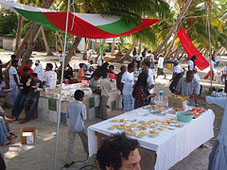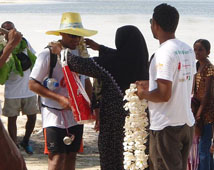Although the MNDF has been drafted in to help combat the problem of dengue fever that is affecting Male and several other atolls, it is important that people don’t stand back and think that this action alone will solve the problem.
Experience in many other countries has shown that a ‘top-down’ or vertical campaign against dengue fever is only part of the solution to preventing outbreaks of the virus from getting worse.
Most people know that dengue fever is spread by a mosquito that takes the blood of an infected person. The blood contains a virus that causes dengue fever and this is passed on to a new person when they are bitten in turn by the mosquito. The mosquito seems fine – but people infected by the virus may become very seriously ill and a small proportion may die.
Most action to prevent the spread of dengue fever is aimed at the mosquito itself. If the mosquitoes are stopped from breeding then the transmission of the dengue virus from person to person will be interrupted and no new cases will occur. Often the strategy against the mosquito relies on spraying chemicals and treating water storage containers. But without having fully integrated community involvement, this strategy has failed almost everywhere in the world that it has been tried. The mosquitoes will always find ways to outwit their human adversaries unless locally tailored eradication programmes are implemented.
Community involvement is key to the success of the eradication programme and every member of the community should be involved in understanding the problem of controlling the mosquitoes (vector control). Within each community the local community leaders should be involved in forming a dedicated steering committee that can create formal task forces or community working groups that will undertake environmental management. The working groups will need to know in detail exactly what they are supposed to be doing and precise training sessions need to be organised. Every locality is different so each community task force needs to identify the exact local conditions in which their mosquitoes will be breeding. Precise local knowledge is the most important resource for beating the disease. In particular waste water needs to be evacuated efficiently; water pipelines and water storage containers must be protected and communal waste collection improved.
A research programme in Cuba compared the usual ‘top down’ ways of combating dengue fever with a community activist approach as described above. They found that the community based environmental strategy was much more effective that the usual eradication programme. You can read more about this research on:
http://www.bmj.com/content/338/bmj.b1959.full
Garbage: a special problem throughout the Maldives
The mosquitoes love little collections of water. When I was in the Maldives as a volunteer for the Friends of Maldives health programme I noticed that outside almost every house there is a little collection of garbage. This includes plastic drink containers, tins, discarded tyres, containers and invariably a pile of half coconuts. These are ideals breeding sites for the mosquitoes that carry dengue fever. Unless each and every one of these piles is cleaned up, dengue fever will continue to be a problem throughout the Maldives in urban and rural areas.
Mosquitoes love the little collections of water that form in garbage piles.
Dr Tom Heller is a Senior Lecturer in the Open University’s Faculty of Health and Social Welfare. He has previously visited the country as a medical volunteer for the UK-based NGO, Friends of Maldives.
All comment pieces are the sole view of the author and do not reflect the editorial policy of Minivan News. If you would like to write an opinion piece, please send proposals to [email protected]



